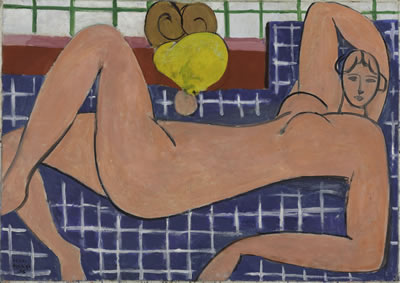The legendary Cone sisters of Baltimore – Etta and Claribel – amassed a huge collection of modern art, particularly rich in the work of Henri Matisse. It is, in fact, the largest Matisse repository in the world – oils, sculptures, prints, drawings, illustrated books – 500 items in all – and it came to include work by Picasso, Gauguin, Cézanne, Van Gogh, Courbet, Renoir, and others. The show at the Nasher contains the first and one of the last Matisse paintings the sisters bought and takes us down some of the byways of their collecting careers. Their first purchases, in fact, were home-grown: “In the Grove” is a pleasant enough impressionist work by the American Theodore Robinson, one of five Etta bought when, in 1898, she was given $300 to decorate their home. Three years later she landed in Europe, met Leo and Gertrude Stein, and together with Claribel discovered the Parisian art world.
For me, the two most interesting Matisse paintings here are the early Fauvist “Yellow Pottery from Provence,” and the much later “Large Reclining Nude.” The Fauvist painting (the work of a “wild beast” to certain Parisian critics), with its blank areas and brash colors, must have given Etta pause. We know that the large nude did require a bit of canny salesmanship by Matisse. The nude’s curling outlines and elongated torso set flatly against squared blue tiles and a nest of pillows would not immediately be recognized as a genuine masterpiece. Look carefully at the lines of white grouting – at the subtle shifts in the shapes of the squares as they surround the nude’s body.
Picasso is represented by some drawings, including a mocking self-portrait, but also by a superb blue period “Woman with Bangs,” its one figure solid, stolid and statuesque. It hangs near Gauguin’s “Vahine no te vi” (Woman with a Mango). Filling almost the entire canvas, with her purple dress against a yellow background, she is a powerful figure in a powerful painting. The Nasher show has a Cézanne lithograph, “Large Bathers,” but I know that Claribel also provided Baltimore with one of Cézanne’s finest, “Mont Sainte-Victoire seen from the Bibemus Quarry.”
The show went first to The Jewish Museum in New York City, where the curators apparently sought to provide a sense of everything the sisters bought and everywhere they went, including a trip around the world where the sisters bought the exotic textiles and jewelry that fill several rooms at the Nasher.
It is unique among the Cone travelling shows I have seen in the large number of Matisse bronzes it contains, their nude surfaces rippling, their shapes and movements emulating those of the paintings. In all, I count 29 Matisse paintings, drawings and bronzes in the show.
The sisters bought their huge collection for their own delight, and while they lived it decorated their own apartments. Ultimately it went to the Baltimore Museum of Art, which spreads the work everywhere it can. “Collecting” will be at the Nasher through February 10 of the new year.
For details of the show, see the trio of sidebar items.












